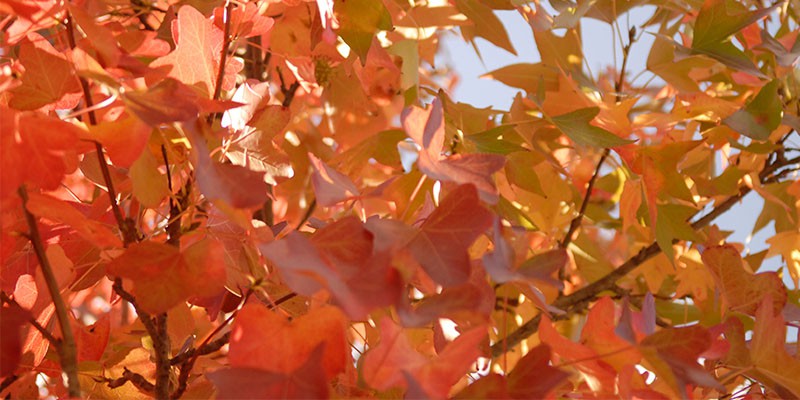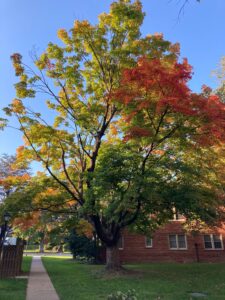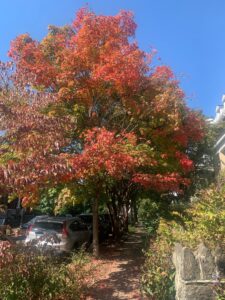THE LEAFLET

Enjoying the Colors of Fall
Cherry trees in DC typically get all the love, but when October and November roll around we’ve all but forgotten those dainty pink buds and are enthralled instead by the fiery hues of fall foliage that blanket the District.
And thus, our area’s peak fall foliage season will soon be upon us. Local experts agree that leaves will reach peak vibrancy sometime in the next week or two – the later half of October. As we admire our magical maples, shocking yellow ginkgoes, and the rainbows of sweetgums, we may wonder – just why do leaves change color and drop off trees in the fall?
Before we start, remember that you can bring the magical show of fall to your yard by adding a tree for free through our Residential Planting Programs – and even filter through our urban hearty tree list by trees that will bring excellent fall colors!
You can also admire the show of fall from your front stoop or back patio by checking out our Fall Colors Map, which highlights showstopper trees and trees with interesting fall color. It includes trees Casey Trees has planted, as well as trees planted and managed by the city’s Urban Forestry Division.
 As autumn sets in and the air turns crisper, the natural world undergoes its own seasonal transformation. While some trees remain resolutely green throughout the year, others embrace the spectacle of changing colors, painting the landscape with vivid hues. This striking phenomenon is a hallmark of deciduous trees, such as the iconic oaks, elms, and maples that captivate our senses during the fall season.
As autumn sets in and the air turns crisper, the natural world undergoes its own seasonal transformation. While some trees remain resolutely green throughout the year, others embrace the spectacle of changing colors, painting the landscape with vivid hues. This striking phenomenon is a hallmark of deciduous trees, such as the iconic oaks, elms, and maples that captivate our senses during the fall season.
Unlike their coniferous counterparts, which remain largely unchanged in color, deciduous trees embark on a splendid journey as they prepare for the impending winter. Guided by environmental signals, these trees gradually withdraw nutrients from their branches, conserving energy to endure the upcoming colder months. This transition is triggered by a combination of dwindling daylight, cooling temperatures, and nature’s subtle cues.
 The captivating interplay of pigments within the leaves orchestrates this seasonal performance. The dominant green of spring and summer owes its brilliance to the presence of chlorophyll, the primary pigment responsible for photosynthesis. During these sun-drenched months, chlorophyll reigns supreme, giving us lush green leaves, capturing sunlight, and converting it into vital energy for the tree.
The captivating interplay of pigments within the leaves orchestrates this seasonal performance. The dominant green of spring and summer owes its brilliance to the presence of chlorophyll, the primary pigment responsible for photosynthesis. During these sun-drenched months, chlorophyll reigns supreme, giving us lush green leaves, capturing sunlight, and converting it into vital energy for the tree.
As the days shorten and temperatures drop, the reign of chlorophyll wanes, giving way to the emergence of other pigments, such as carotenoids, which paint the foliage in warm hues of yellow and orange. In certain cases, anthocyanins add a touch of crimson to the autumnal palette, infusing the landscape with a breathtaking range of reds.
Simultaneously, however, the effects of climate change are increasingly evident, subtly altering this seasonal spectacle. With erratic weather patterns and warmer autumns, the transition to fall hues is less pronounced, the colors less vibrant, and the timing less predictable. The gradual shift in the climate’s rhythm has disrupted the delicate balance of the natural world.
 In the background of this whole color-changing process, the tree is also entering a sort of hibernation mode – slowing down the flow of nutrients out to the limbs, hunkering down to conserve energy so it can make it through the winter. After a leaf has cycled through its pigments, it begins to run out of energy and starts to die off. Specifically, the leaf starts to weaken at the stem, making it easy for wind, animals, excited children etc. to drop the leaves off the tree. The move from green to yellow and orange, to maybe a red grand finale is a bit like each pigment in each leaf taking a final bow before winter.
In the background of this whole color-changing process, the tree is also entering a sort of hibernation mode – slowing down the flow of nutrients out to the limbs, hunkering down to conserve energy so it can make it through the winter. After a leaf has cycled through its pigments, it begins to run out of energy and starts to die off. Specifically, the leaf starts to weaken at the stem, making it easy for wind, animals, excited children etc. to drop the leaves off the tree. The move from green to yellow and orange, to maybe a red grand finale is a bit like each pigment in each leaf taking a final bow before winter.
As we previously mentioned in the last installment of our Mythbusting series: Trees and Leaf Litter, consider letting the leaves that fall off your trees this season run their natural course. As they break apart, they will turn into a nutrient-rich organic matter that will provide valuable nutrients back to the soil and are a natural mulch that helps suppress weeds and protect roots from temperature extremes.